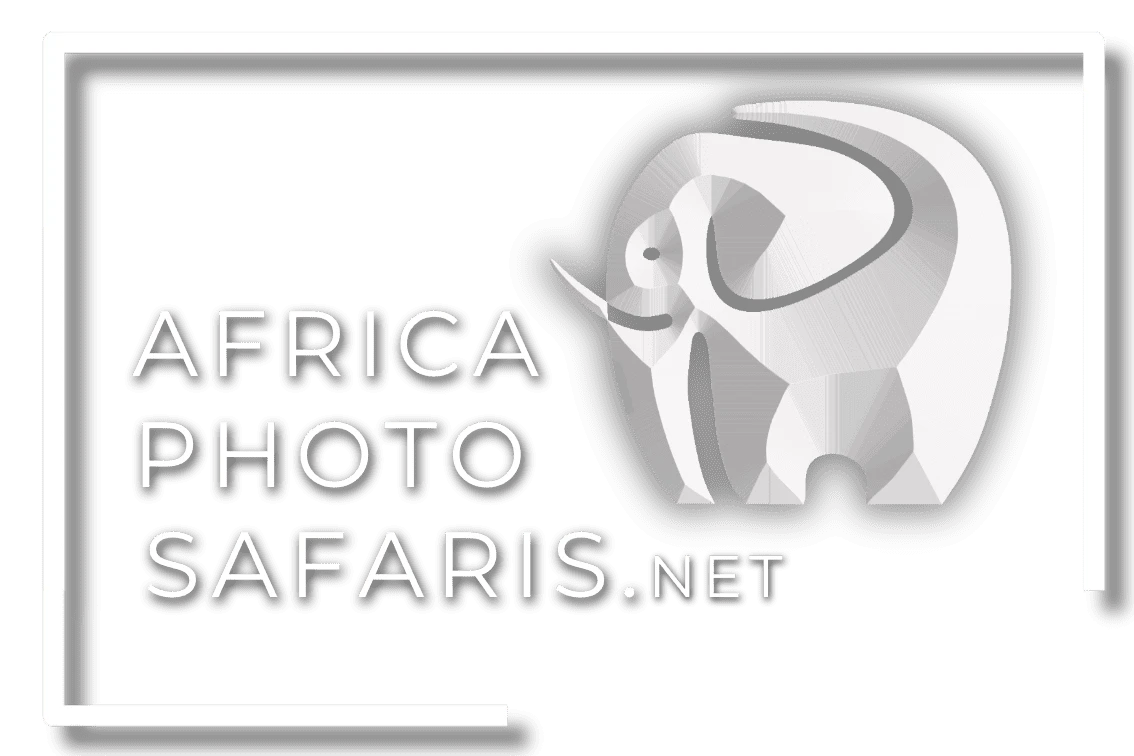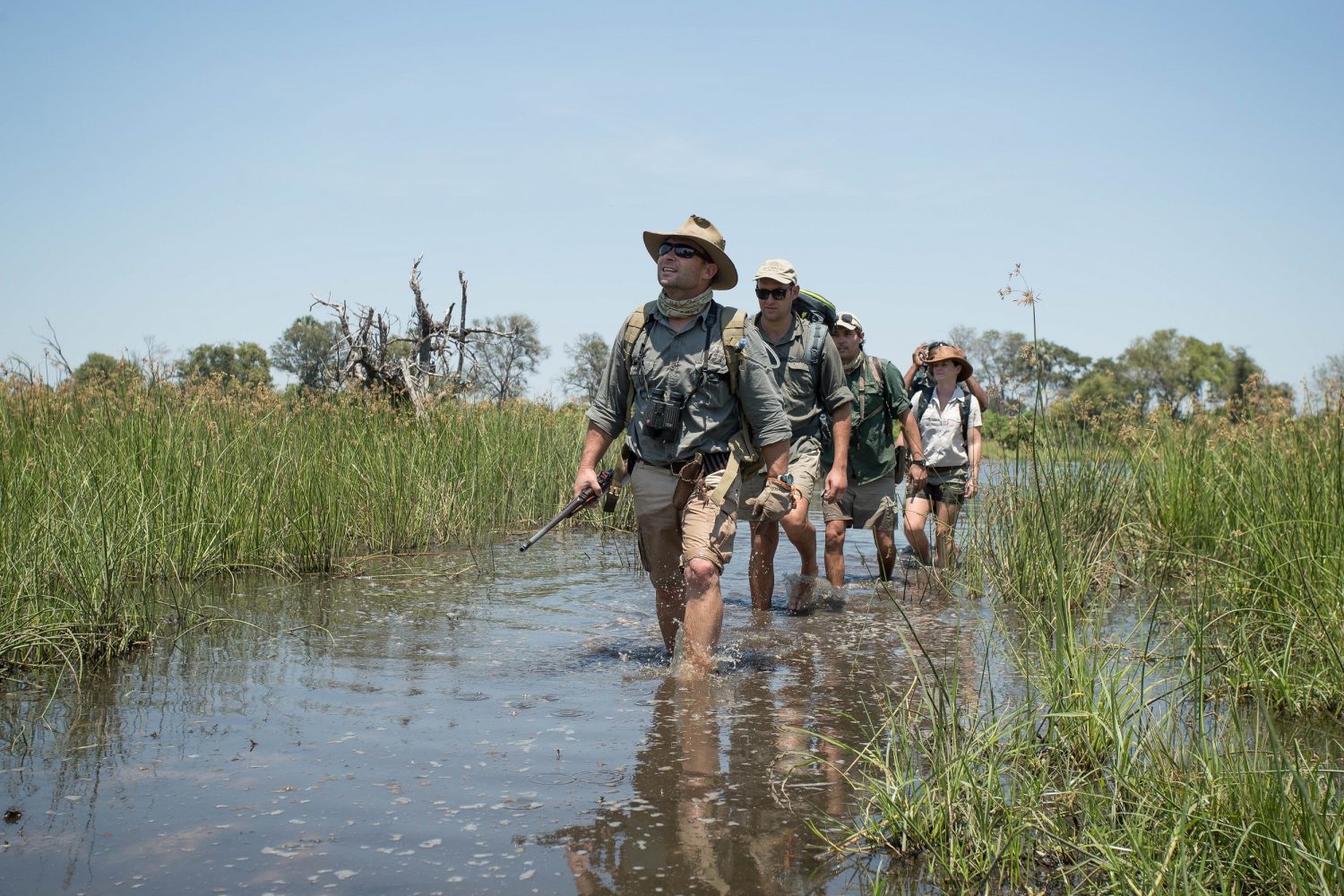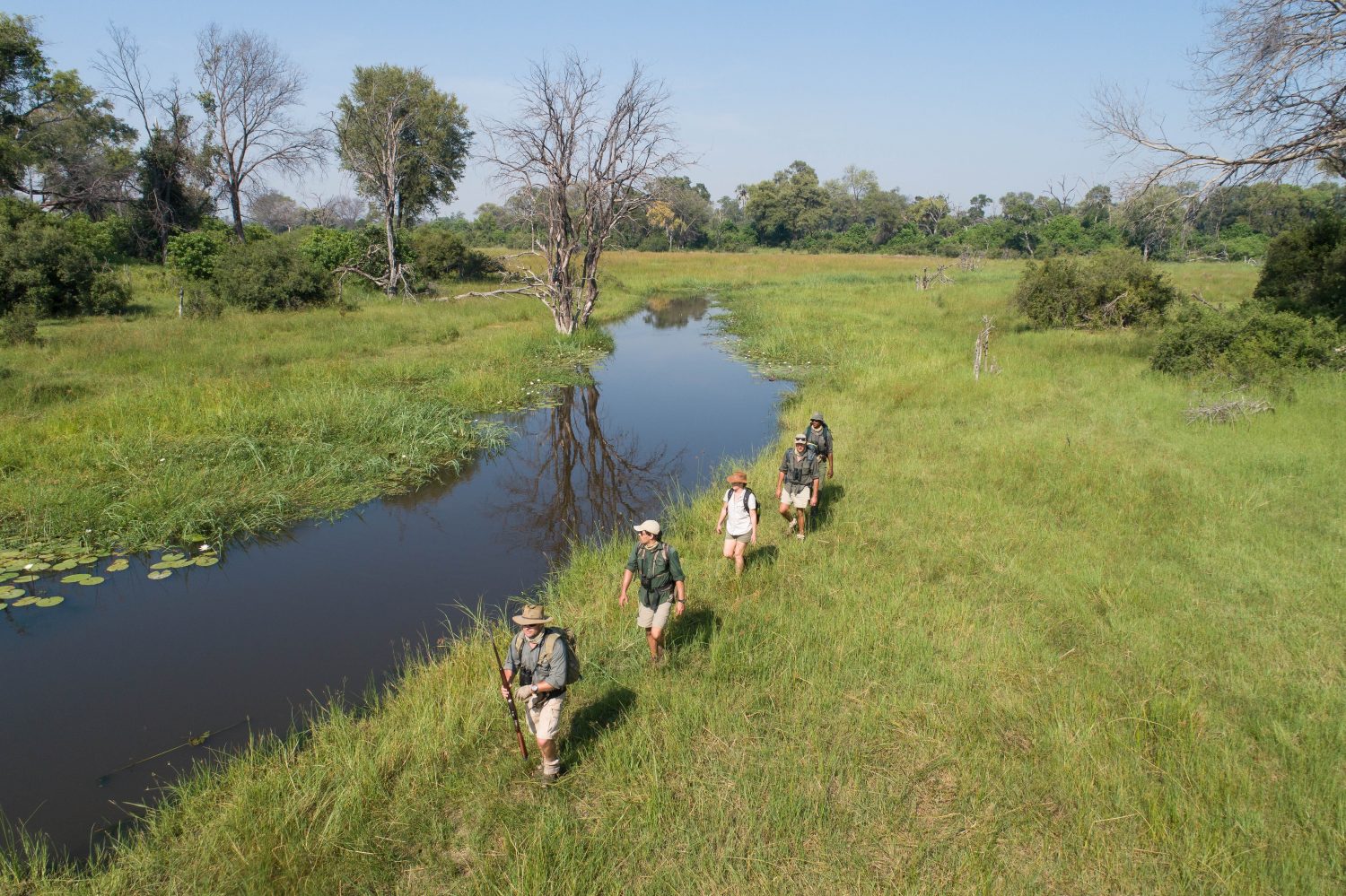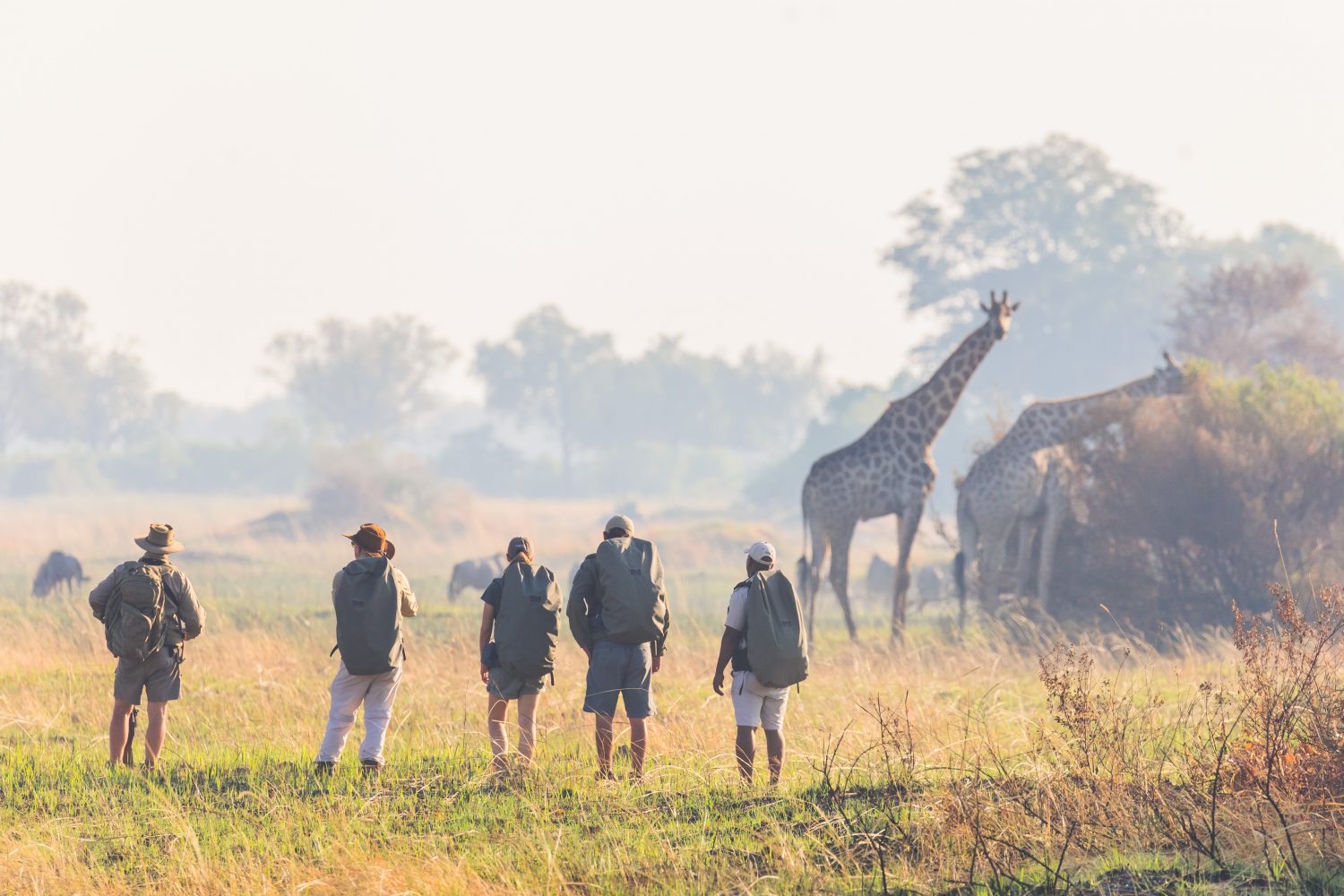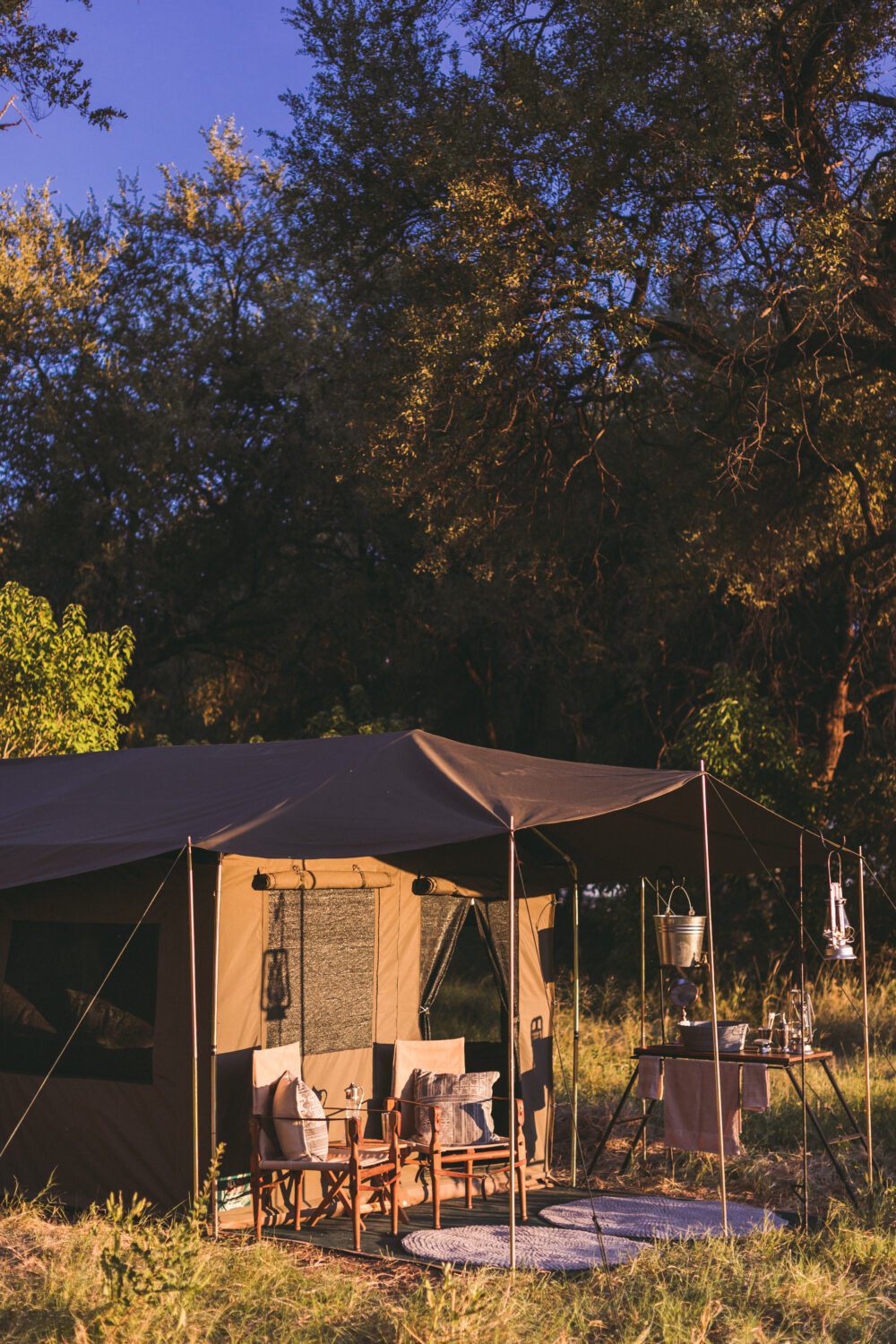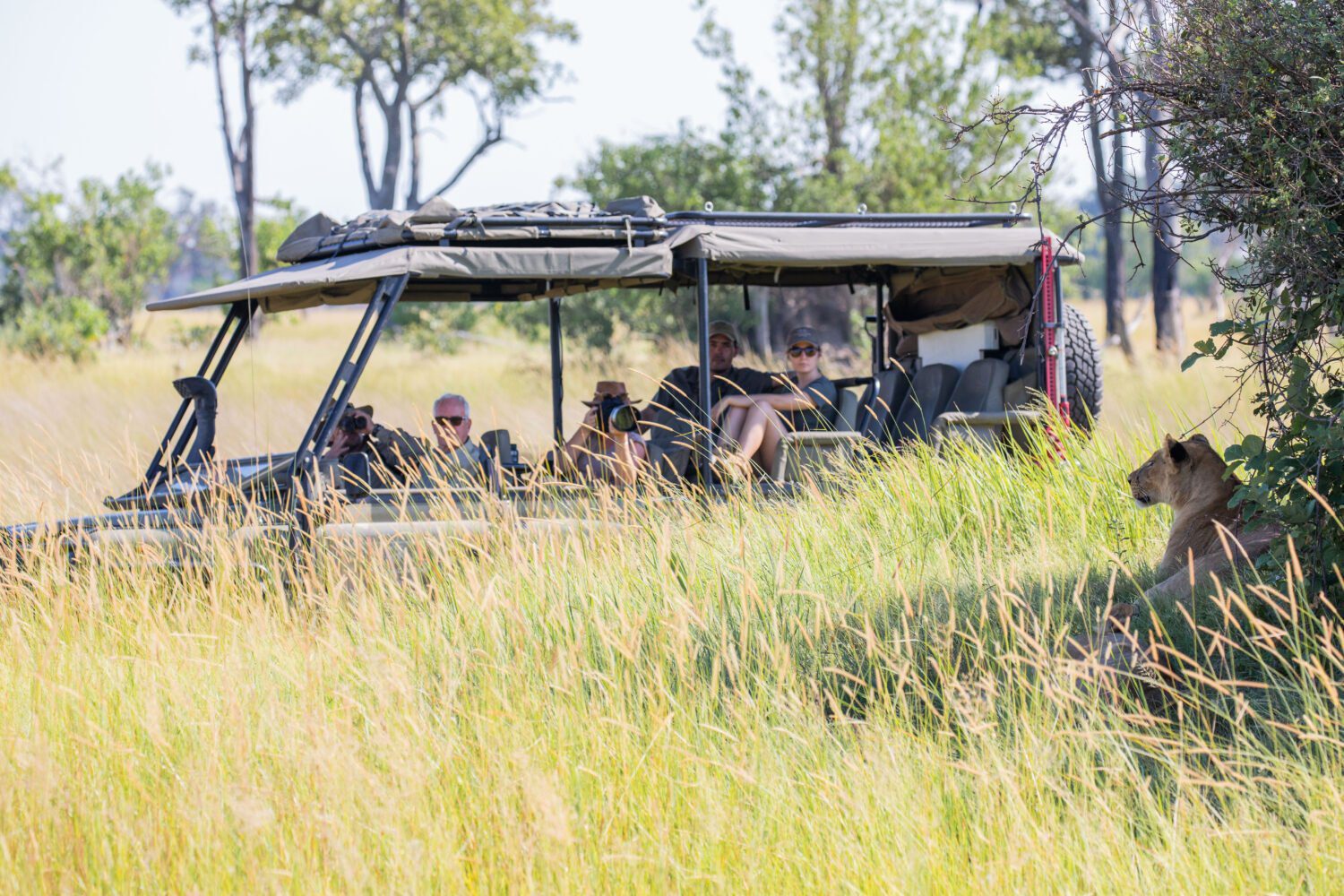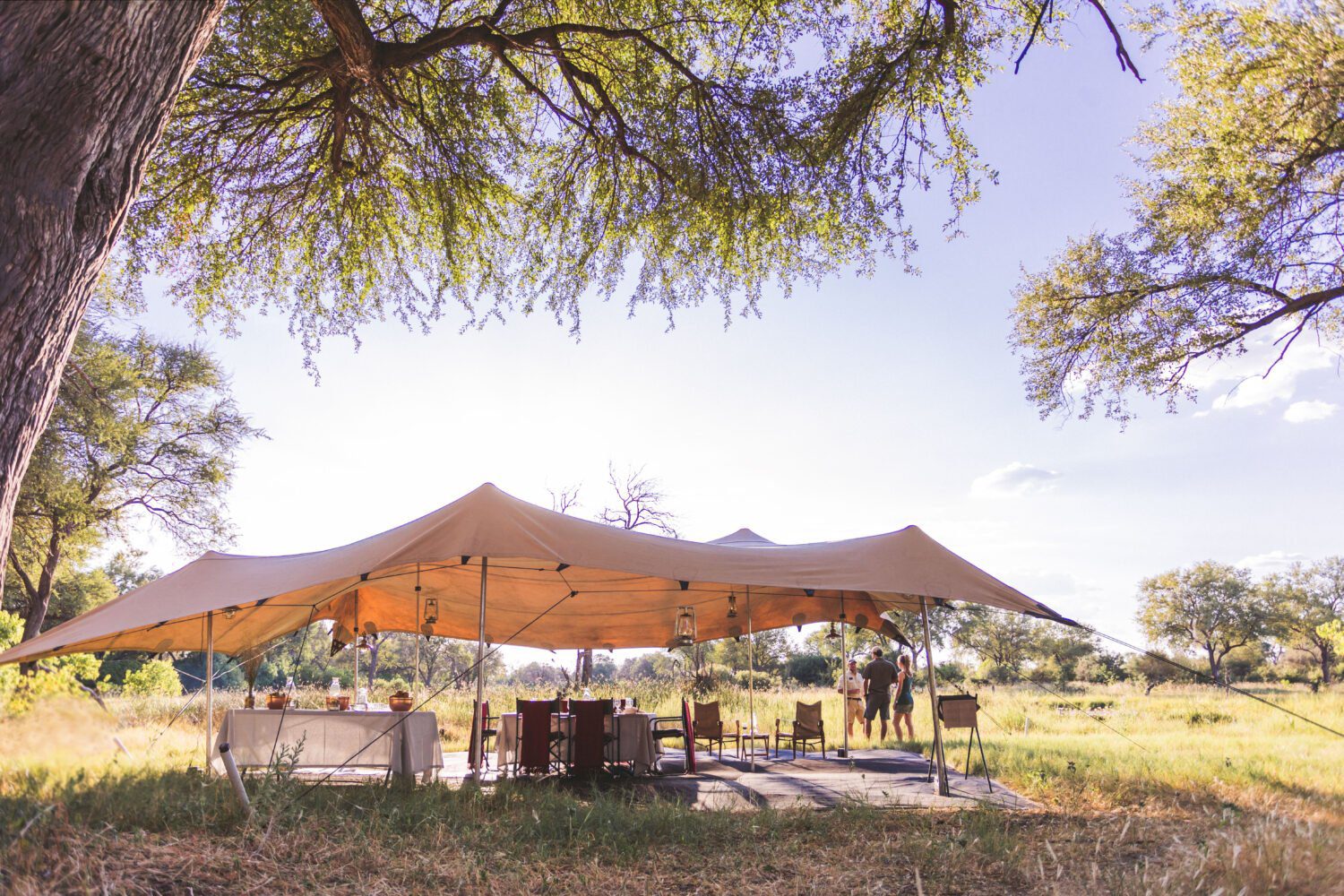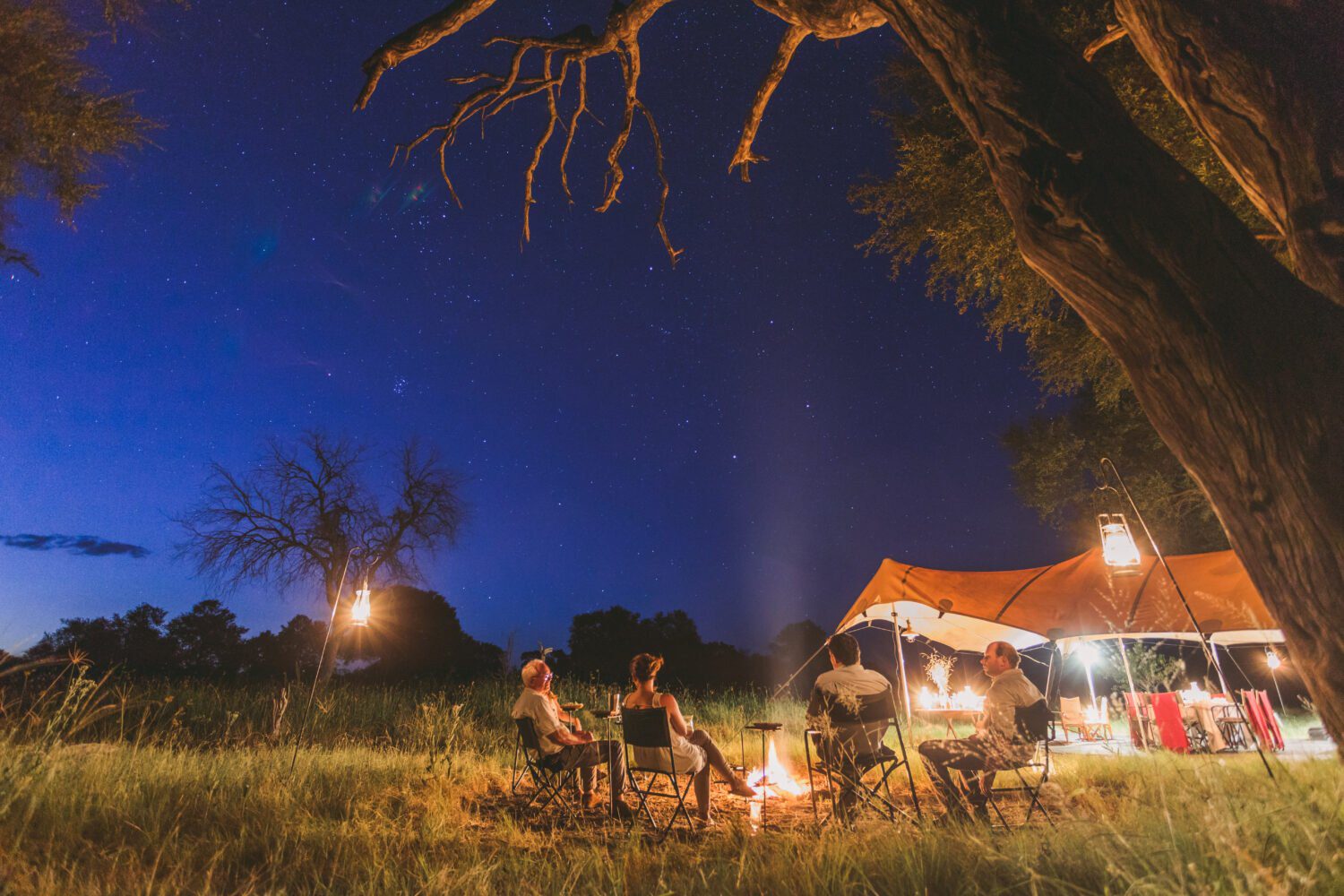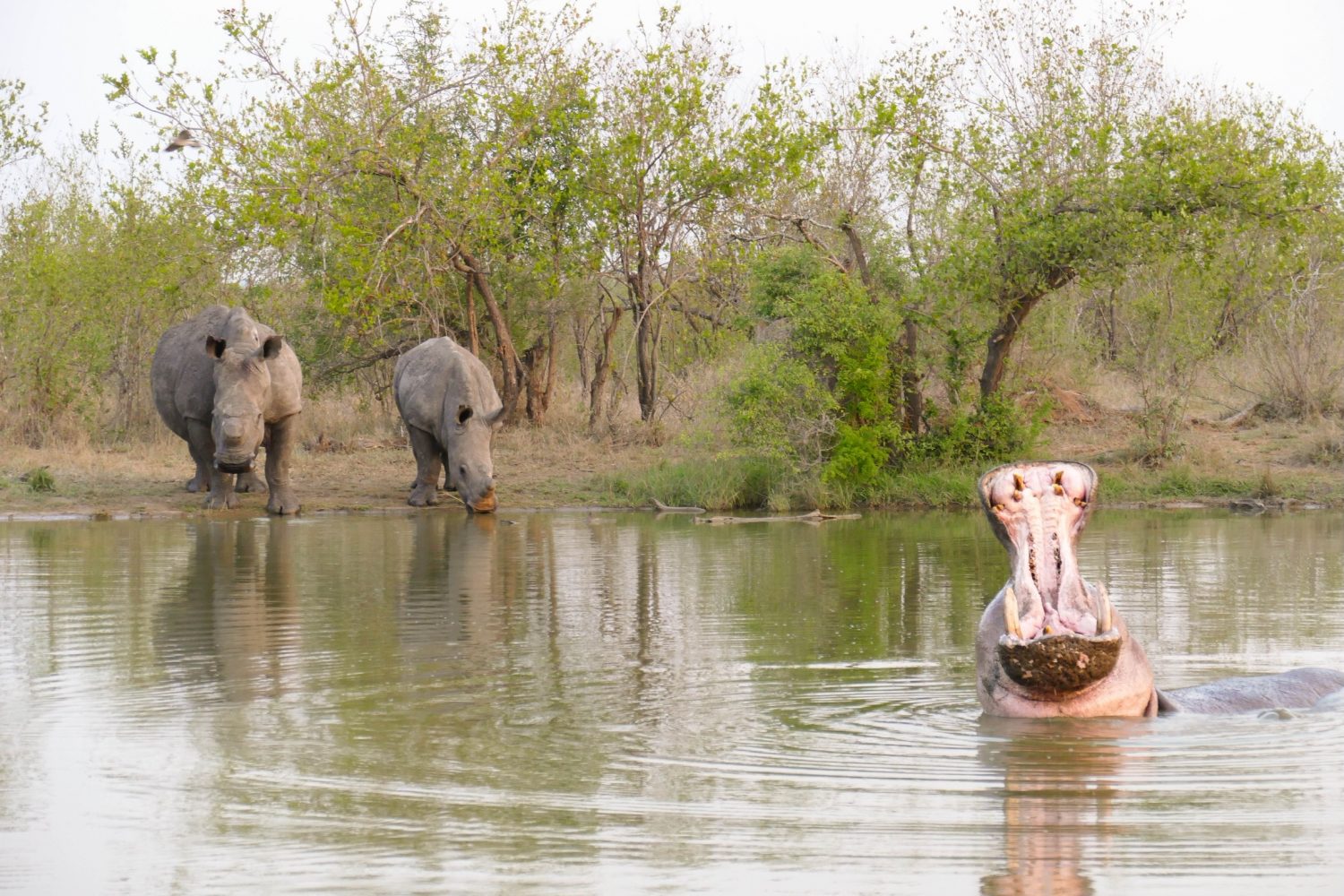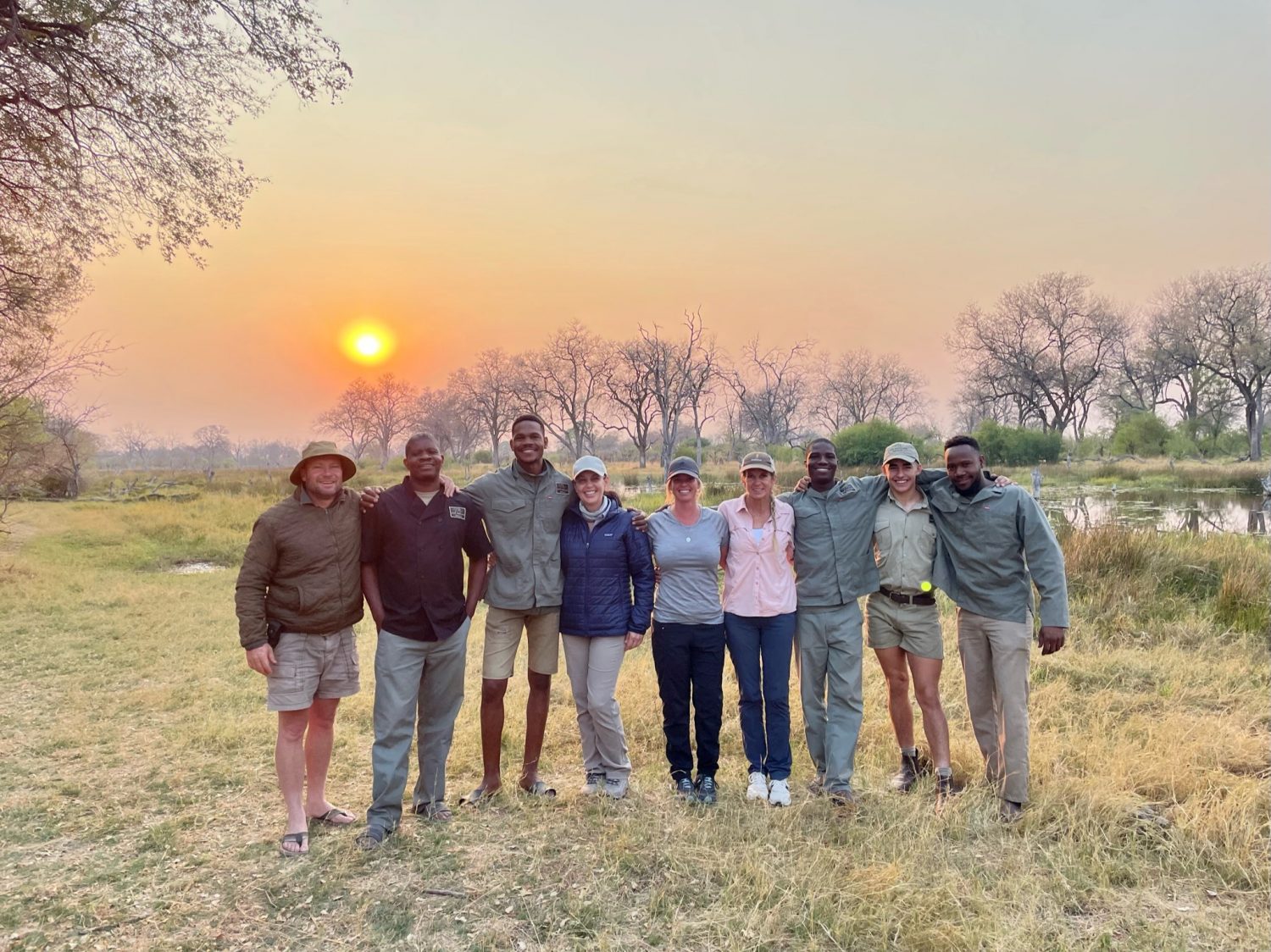💚
WHY YOU’D LOVE IT!
African safari guides are arguably the most important part of a safari experience. They are storytellers, explorers, conservationists, botanists, food and wine connoisseurs, history enthusiasts, and curators of once-in-a-lifetime adventures. If you have a great guide, you’re guaranteed to experience Africa in one of the most exclusive ways.
Mobile,Walking & Privately guided safaris in Botswana are, without a doubt, the best way to experience one of Africa’s last un-spoilt wilderness areas!
Safaris are an active and far more intense style of safari, and at the same time, it offers a feeling of freedom that you may never experience again, freedom in one of the wildest places in the world. It is considered the purest form of safari you can experience in today’s world and allows you to relive some of the first explorers of Africa’s day to day experiences!
Not only does walking in the bush force you to tune out the clutter in your head to be able to focus on the world and movements around you, but the requirement of silence between fellow walkers is essential for the safety and success of the walk itself. Not many places or activities today require you to be silent!
The focus is on the quality of the guiding, their motto being, ‘a good guide = a good safari’. Every safari is tailor-made to suit personal interests and requirements and while walking is the focus other activities are offered too.
All Botswana Mobile & Walking safaris are led by an armed guide and accompanied by a backup guide, when there are more than two walking guests.Depending on the location of the walk, it may also involve a tracker to accompany the group.
Experiencing everything up close and personal give a whole new feeling to African and what it beauty has to offer. From walking in wild concession in luxury lodges or walking from comfortable mobile safari.On a “Walking Safari” you will return to the stationary camp each night.
Tailor-made, custom, exclusive & private…all combined world-class game viewing with the benefit of the same guide throughout!
There are many ways to travel, but only walking gives you the opportunity to move at the pace of nature. A walking safari demands that you throw out the clatter of urban life and tune into the bush, to its sounds and smells, the textures, temperature and colors: it is how animals survive…’ – David Bristow
MOBILE SAFARIS
Private, personal & pristene!
A mobile safari is exactly what it sounds like – a journey through a variety of different wildlife habitats, staying for a few nights in each area. When you move location, your camp moves with you!
A mobile safari is essentially a privately guided travel adventure where you are accompanied by your Professional Guide and camp assistants in a private safari vehicle with a fully equipped trailer and/or with a back-up/set up vehicle in very remote wonderful National parks or Game reserves.
Each campsite is simply a designated, secluded area of bush with neither facilities nor fences. Before your arrival and after your departure, there is no trace that anyone has stayed there, and the wildlife is free to wander through camp at any time. ‘…it is amazing to watch the camp disintegrate during breakfast, only for it to reappear in time for sun-downers in a completely different location.’ In the evening, watch amber flames lick hungrily at the charred logs of the campfire as the lilting chimes of miniscule reed-frogs and vociferous crickets float through the cool night air. If you listen closely, you might hear a zebra braying in the distance, an elephant’s trumpet of displeasure or even a rasping, saw-like cough resonating from the inky darkness – the unforgettable call of a leopard patrolling its territory.
The sounds of the bush become more vivid when there is no barrier between you and the wildlife, particularly in the absence of any auditory distractions. Without the monotonous drone of a permanent camp’s generator nor any of the background noise inherent in the operation of such lodges you will find yourself listening to sounds you never imagined existed. And when everything goes quiet, the silence is so intense, it feels almost oppressive. Although activities are similar to a traditional lodge – morning and afternoon wildlife drives, interspersed with the occasional mokoro (traditional dugout canoe) journey or boat cruise – the intimacy of the operation gives you more flexibility.
Normally a mobile safari will involve just one wildlife-viewing vehicle, allowing you to stay out for as long as you like without having to worry about being late for meals. On a mobile, the camp timings revolve around you, not the other way around. Having the same guide for the duration of the trip also allows the focus of the safari to be tailored to the group’s specific interests, which can be adapted according to what you see. This avoids the possibility of listening to different guides repeat the same information or spending longer than desired at similar sightings at different lodges – sometimes an unavoidable consequence of sharing a vehicle with other lodge guests.
For eco-conscious travelers, one of the attractions of a mobile is your reduced carbon footprint. Traveling between locations is done by vehicle instead of the small planes that are used to transfer between lodges, which also gives you the opportunity to watch the subtle changes in scenery as you move from one ecosystem to another. In the camp itself, lanterns are often solar-powered, and camera and phone charging is done with an inverter linked to your vehicle’s battery.
‘For an authentic safari, it is difficult to beat a mobile – the original form of this quintessential African adventure. Sleeping in the wild on a mobile safari, with nothing but a piece of canvas between you and Africa’s wildlife, may not be for everyone, but it makes for a fully immersive experience’. – James Gifford (The Lonely Planet)
WALKING SAFARIS
Walk to your heart’s delight!
A walking safari is a mobile safari with the addition of walking … privately guided safari walks.
Tailor-made, custom, exclusive & private…all combined world-class game viewing with the benefit of the same guide throughout!
Walking Safaris are the purest form of safari, a back to the basics style of safari without compromising on comfort. Loose the luxurious trappings found in many modern camps which distract from the real luxury of the pristine African bush. Walking safaris are an active and intense safari, though not necessarily physically demanding.
Walking safaris are an active and far more intense style of safari. At the same time, it offers a feeling of freedom that you may never experience again, freedom in one of the wildest places in the world. It is considered the purest form of safari you can experience in today’s world and allows you to relive some of the first explorers of Africa’s day to day experiences.
All the walking safaris guides are all highly experienced and rated, and armed. Walking safaris are not permitted in the national parks and therefore all these safaris are planned on private or community concessions which border the reserves and which allow the guides to walk armed.
The focus is on the quality of the guiding, their motto being, ‘a good guide = a good safari’. Every safari is tailor-made to suit personal interests and requirements and while walking is the focus other activities are offered too.
Walking in the African wilderness and experiencing everything up close and personal give a whole new feeling to African and what it beauty has to offer. From walking in wild concession in luxury lodges or walking from comfortable mobile safari.On a “Walking Safari” you will return to the stationary camp each night.
The walking is not considered a ‘stroll’ in the park, as walks often include tracking wildlife, crossing difficult terrain and reaching our set goals for the day, which may mean reaching the next camp for the night. Whilst the walks are generally not fast they are not a stroll in the park either, and may involve crossing difficult terrain and long day walks – all planned in advance depending on abilities. Prior to arrival guests are asked to rate their ability as Stollers (1-2 hours per day) Hikers (3-4 hours per day) or Explorers (6 – 7 hours per day) so the route can be planned accordingly.
The aim is to utilize wilderness not used by other people, not a footprint to be seen or a car track to be walked over. Each walking safari itinerary is tailor made according to your walking ability and additional safari requests.
Additional activities are available, including game drives, boating and canoeing. Helicopters are also used for scenic flights or to move between camps.
Days are flexible and never set in stone, moving with the conditions at the time to make the most of your safari experience.
ARE SAFARIS PHYSICALLY DEMANDING?
Generally, safaris are not strenuous in terms of heavy physical activity, however there are elements, which can be tiring that you need to be aware of when planning your safari.
Long-haul international flights often crossing time zones need to be taken into consideration, as well as your connecting charter flight and/or road transfer to access the camps and lodges.
Once you are in Botswana the light aircraft are very compact and there is a certain amount of stepping and bending to get into the seats. Travellers are also more likely to experience travel sickness in small charter planes than larger commercial flights and this should be kept in mind.
Game drives at the camps/lodges are in open 4×4 safari vehicles. Due to the nature of the terrain the roads are often bumpy and can be a little strenuous for passengers. Open vehicles also expose travelers to the elements more than closed vehicles meaning greater exposure to the sun in summer and icy winds in winter. Generally, safari vehicles have a canopy overhead to minimize exposure to the elements, however there are selected operators, which do not use canopies in order to enhance photographic opportunities.
Southern Africa has varying weather conditions depending on the season.
In winter (May – Sep), expect warm temperatures during the day and very cold nights in accommodation with canvas walls. Hot water bottles, extra blankets and ponchos may be provided to keep you warm in camp and on your game drives to minimize the impact of the cold. In summer (Nov – Apr) you will experience hot days and nights with rainstorms in the afternoons. It is imperative to increase your fluid intake considerably, to avoid dehydration and heat exhaustion. Symptoms include but are not limited to migraines and nausea. In September & October both the days and nights are incredibly hot and may cause discomfort. See temperature chart.
AREAS COVERED ?
Areas of operation in include community wildlife concessions throughout Northern Botswana’s Okavango Delta and the Kgalagadi. Walking is not permitted in National Parks or Game Reserves, thus the areas that border these protected areas are utilized. Additionally, mobile safari and walking safaris are also operated out of a private concession in the western Okavango Delta.
TYPICAL DAY ON A MOBILE SAFARI
Typically, a safari day in Botswana includes two major activities per day – one beginning early in the morning and the second starting in the mid-to-late-afternoon and continuing until dark. If you are staying in a private concession or community area the afternoon activity may extend into a night drive up until two hours after sunset.
Early AM
The day starts with the rising of the sun. Your wake-up call will be between 5 am and 6 am – a gentle “koko” (‘knock knock’ in Setswana) at the entrance of your tent. Your wash-hand basin will be filled with steaming hot water and freshly made tea and coffee will be served around the campfire. Wake up to the warmth of the morning sun at the dawn of a new day.
A light breakfast will be served before the early morning game drive. We do our best to get out as early as possible as this is key game viewing time of the day.
The mornings are the best opportunity to follow fresh tracks and see game interactions, as some of the nocturnal animals are still active. The game activity normally lasts 3 – 5 hours depending on what you see and the nature of the activity.
During the morning activities you will undoubtedly stop for coffee and a little morning snack overlooking a beautiful scene. Having spent the morning exploring the surrounding wilderness in search of Botswana’s hidden treasures either on foot or game drive, you will return to camp for a bountiful lunch spread. We sporadically do a bush lunch in a separate location to your camp to change the scenery for you and then return to camp afterwards.
Morning activities are usually over by late morning (around 11h00) and guests will return to camp for a full breakfast/brunch. The early afternoon is spent resting and relaxing in camp as this is the hottest part of the day and animal activity is minimal.
Mid Day
Just as the animals retreat to escape the heat of mid day, so will you! This is your time to enjoy reading, chatting, taking a shower, just relaxing or taking a nap, the well-recognized ‘siesta’ time of the day.
If you are on an explorer’s walking safari, we do spend some of the lunch and siesta time of the day out in the bush rather than returning to camp, especially during days where we are walking from one location to another. In this case, we will be carrying lunch with us or have a bush lunch set up where we too will take a little snooze mid-day to recuperate for the rest of the days walk.
Afternoon
Head out into the wilderness once more as the animals awake from their days slumber and gather at the watering holes to quench their unforgiving thirst. As the sun sets on the horizon, one can only marvel at the sheer splendour of an African sunset and with refreshments in hand, toast to the wonder of nature. We do warn you that this is prime game viewing time of the day, so don’t be surprise if our guide shivy’s you back onto the car for some more game viewing action with your drink in hand!
Evening
On your return to camp, you can enjoy a hot shower under the starry night sky and gather around the warmth of the camp fire with your fellow companions to relive the day’s events and excitement.
Enjoy a three-course dinner fit for a king served with a selection of fine wines against the magical backdrop of the African night sky.
After dinner, drinks may be enjoyed around the fire however most people find they are tired from the fresh air and early start and are in bed by 11 pm.
Retreating to the comfort of your tent after enjoying a night cap around the campfire, you can fall asleep to the calls of the African wild. Good night!
On moving days, the safari team will pack down the camp, traveling ahead in the back up vehicle to prepare the camp for your arrival at the next location. When traveling between locations, the route is most commonly through the parks and reserves and is therefore an extension of your daily game drives. A picnic lunch can be enjoyed en-route.

3 LEVELS OF “WALKERS”
The categories below are used to set itineraries for guests, as each area will be more suitable to a specific type of walker and safari goer. Additional activities such as boating, game drives and canoeing will also determine the areas that we select. All tailor-made walking safaris use mobile safari camps as the basis for accommodation with the addition of a night or two in a selected lodge that fits in with the walking trail.
STROLLERS
Interested in leisurely walks of up to 1 – 2 hours per day, with game drives and other activities during the rest of the time. The walks will include a stroll along a water way or to a waterhole returning to camp or stopping at a designated pick up site.
Walk, ride and explore at your own leisurely speed!
HIKERS
Dedicated walkers, able to do 3 – 4 hours of walking at a time at least once per day, with game drives and other activities during the rest of the time. This allows out walkers to get some tracking of game under their belts and put some distance under their feet as they explore the wilderness around camp. Unless a designated pick up spot is previously arranged walkers will return to camp typically for lunch and continue safari activities for the rest of the day.
EXPLORERS
Avid and fit walkers, able to do up to 6 – 7 hour of walking per day if needed. Breaks will on certain days be taken out in the bush only returning to camp at the end of the day. For walking itineraries that include walking from one camp location to another, we will require explorer walkers. Minimal to no game drives are included in this style of walking unless specifically arranged. Night drives can be arranged depending on the area.
ACCOMMODATION
The definition of a safari ‘tent’ or chalet is very broad, however generally a tent is a walk-in structure with canvas walls, varying in size, whereas a chalet will generally feature a more solid wooden frame, often with large panels of mosquito screening to open chalets up to the bush. Tents can be anything from a 9 feet dome tent with bed rolls in the most basic accommodation types, up to extremely spacious accommodations which may be 200 feet with separate rooms, both indoor and outdoor bathrooms and only a canvas wall or ceiling to attest to the fact that it is, technically, a tent.
ADVENTURE CAMPING
You won’t even know that you are not in your bed at home, except for the incredible night sounds of the African bush that lull you to sleep. High density foam mattresses sit on raised ‘cots’ inside your two-man dome tents. Don’t fret about those nippy nights as you will be accompanied in bed with a hot water bottle to keep the chill away.
Tents are equipped with a rechargeable light that will provide ample lighting inside your tent for before sunrise or after sunset needs.
The en-suite tents boast a spacious bathroom space attached to the back of your two-man dome (10’ x 10’) tent. The bathroom is open to the sky, providing you great views of the magnificent trees and starry nights while showering. Bathrooms are equipped with a shower, long drop toilet and table for your ablution needs. Steamy hot water is most certainly a necessity, whether it be in your bucket showers or in the raised canvas basins in front of your tent, for washing hands, brushing your teeth or washing the dust from your feet. For relaxing at your tent, canvas director chairs are provided for you to fully immerse yourself in the natural setting of your camp.
Your very own safari chef will make sure that not a moment of the day goes past that you think about food before it thinks of you. Breakfast includes a hot option, as well as cereals and yoghurt, lunches are buffet style with a selection of salads, pies or fresh breads, topped off with high tea in the afternoon, catering to the sweet tooth in us all, finishing the day off with a three course dinner under the starry night sky. Let’s not forget the snacking opportunities provided during the day in the form of a coffee stop in the morning and a sundowner snack is the afternoon.
Alcoholic and non-alcoholic beverages, juice and water are provided throughout this style of safari, always served cold unless specifically wanted otherwise. Safari vehicles are also equipped to charge all your ‘bells and whistles’ that you need to capture those sacred memories of your amazing safari in Botswana!
LUXURY CAMPING
On this level of safari, a Sahara tent is provided. These spacious tents are equipped with full on beds, luxurious linen, extra pillows and a standing wardrobe. Large windows provide amazing views of the landscape around you, as well as any wildlife activity that may pass your way.
Attached to your tent is a spacious en-suite bathroom, fitted with a long drop toilet and washing facilities including a basin with running water and a bucket shower, with an extra big shower head for your showering enjoyment. Our long drop toilet is also a super lux version with a wooden toilet seat with a flushing handle.The lux bathroom is uncovered providing each and every opportunity for you to enjoy nature around you. Situated on your veranda is a vanity table together with basin and running water.
Also outside your tent is a relaxing area just for yourselves, with comfortable chairs and a small table to store your reading material or binoculars on as you enjoy the wilderness around you.
Your very own safari chef will make sure that not a moment of the day goes past that you think about food before it thinks of you. Breakfast includes a hot option, baked option, as well as cereals and yoghurt, lunches are buffet style with a selection of salads, pies or fresh breads followed by a cheese board, topped off with high tea in the afternoon, catering to the sweet tooth in us all, finishing the day off with a three course dinner under the starry night sky. On one of the nights on safari, the desert will take place in the form of a wine and chocolate pairing, something our guests rage about! Let’s not forget the snacking opportunities provided during the day in the form of a coffee stop in the morning and a sundowner snack is the afternoon. To step up the coffee experience, we are able to provide our guests with cappuccino, espresso or latte’s, together with a good selection of coffee options, with mostly African based beans. To spice up the sundowners, a cocktail afternoon is included, just to add a bit of variety for your drinking pleasure.
Alcoholic and non-alcoholic beverages, juice and water are provided throughout this style of safari, always served cold unless specifically wanted otherwise. For our super lux guests, we also provide specialized alcoholic beverages such as limoncello and flavored gin’s.
Safari vehicles are also equipped to charge all your ‘bells and whistles’ that you need to capture those sacred memories of your amazing safari in Botswana!
BOTSWANA PARKS & RESERVES
See where you’re going!
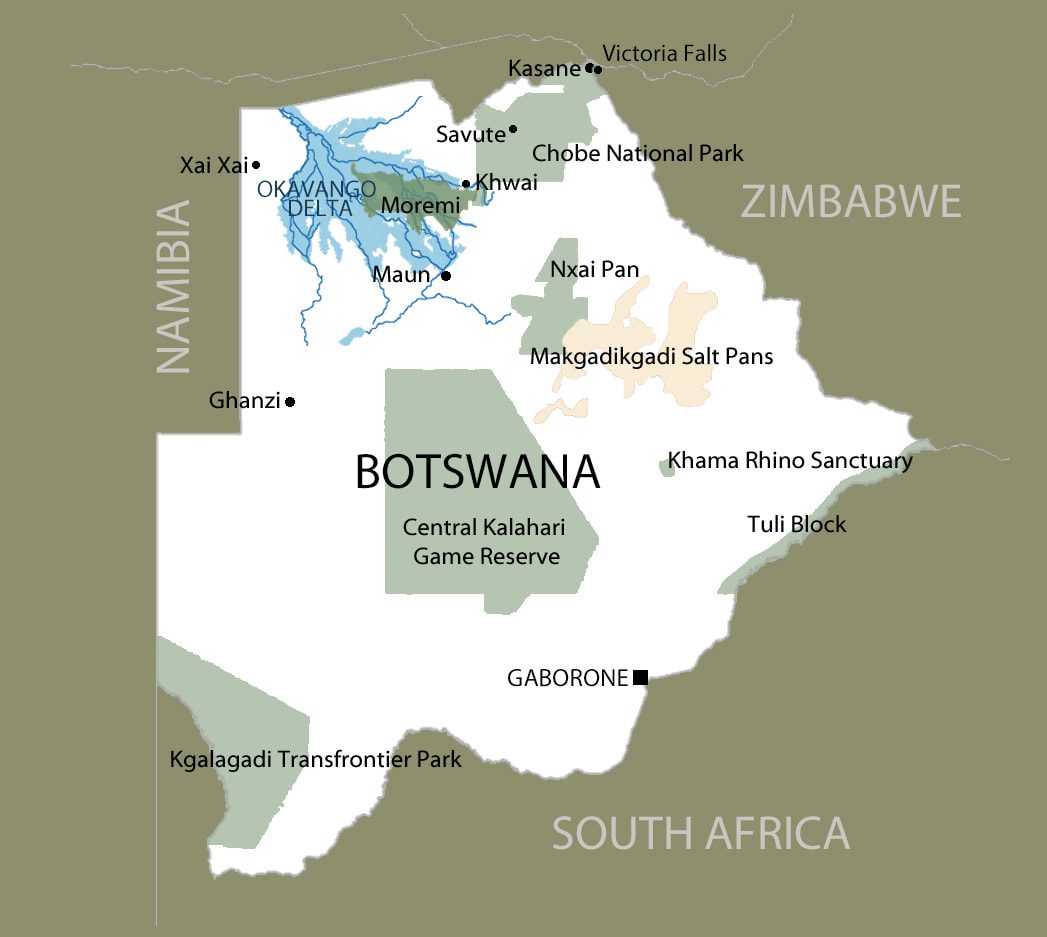
LOGISTICS
FAQ’s
HEALTH
SEASONS
Whats is a mobile safari?
A mobile safari is a type of safari experience where participants move between different locations within a wildlife area or national park, typically in a group or small convoy. Instead of staying at a fixed accommodation, such as a lodge or camp, the participants stay in temporary camps that are set up and dismantled as the safari progresses. These camps are often designed to provide basic yet comfortable accommodations, with amenities such as sleeping tents, communal dining areas, and shared bathroom facilities.
During a mobile safari, participants have the opportunity to explore different areas and ecosystems, maximizing their chances of encountering diverse wildlife species and experiencing varied landscapes. The safari guides and staff set up the camps in strategic locations to offer the best wildlife viewing opportunities, often moving every few days to follow animal migration patterns or explore different regions.
Mobile safaris are typically led by experienced guides who possess extensive knowledge of the local wildlife and ecosystems. They provide informative game drives and guided walks, offering insights into the natural surroundings and the behavior of the animals encountered along the way.
This type of safari appeals to adventurous travelers who enjoy a more immersive and flexible experience, as it allows for a closer connection with nature and the ability to explore remote and lesser-known areas. Mobile safaris can be organized in various destinations across Africa, including countries such as Botswana, Tanzania, and Zambia, among others.
International flights
The minimum connection time at Johannesburg Airport is supposed to be 90 minutes, however we recommend a minimum of 2-3 hours, when connecting on to Botswana (from an international or domestic flight). On departure from Botswana, we recommend you allow 3-4 hours before your onward connecting flight to allow for delays or late notice scheduled time changes which can be a common occurrence.
It is essential to ensure that your full name as stated in your passport matches that of your international airline ticket. Tickets issued in an incorrect name may result in you being denied boarding and potentially incurring additional costs for the purchase of a new ticket.
Any guests travelling with children under 18 years of age, under both Botswana and South African law, must carry the appropriate documentation: an unabridged birth certificate, passport, and affidavit from both parents if they are travelling with only one parent, or a 3rd party, authorizing their travel with the child(ren). Contact us for further details. This applies to guests transiting (i.e., flying through Johannesburg) or travelling in South Africa or Botswana.
When arranging your international and regional flights for the start and end of your safari, please bear in mind that charter aircraft cannot fly after sunset/ during hours of darkness. You need to arrive on the first day of your safari with sufficient time for charter aircraft to fly you to camp and return to the point of origin before sunset, as well as allowing for any potential delays with immigration.
If booking a flight scheduled for arrival within 2 – 3 hours of sunset, a pre-night in the town of arrival is recommended as any flight delays will result in you losing your first night on safari and having to lay-over at a local hotel/guesthouse at your own expense. Similarly, on your day of departure, light aircraft can only fly out of the originating airport and into camp to pick you up after sunrise. If your connecting flight is scheduled for the early morning, you may need to spend a night in town to allow you to connect with your international/regional flight.
Charter flights
On fly-in safaris, movement between camps is generally by a light aircraft due to remote areas visited and distances travelled. Light aircraft used for inter-camp transfers vary in size from 3,5,7 & 12 seater aircraft. The most common makes of aircraft used are the Cessna C182, C206, C210, C207, Cessna Grand Caravan, Britten Norman Islander, and the Gippsland Airvan. Air transfer times vary between twenty minutes to one hour twenty minutes depending on your itinerary. The flight departure and drop off times are scheduled by air charter companies the day prior, to fit in with their flying schedule, therefore we cannot advise travel times in advance. Most transfers are scheduled between activities or to suit your flight arrival/departure times.
To keep the cost of the air transfers reasonable, the lodges in the region co-operate to share daily schedules wherever possible. The rate you have been quoted is therefore ‘A SEAT IN A PLANE RATE’ (unless otherwise specified) rather than a private charter rate, meaning you will share the aircraft with guests flying to other lodges/camps. As a result, your aircraft may stop up to three times at airstrips enroute to your destination to pick-up and drop-off other travelers.
Charter aircraft cannot fly during hours of darkness. If you arrive too late for the pilot to make a return flight, you will have to overnight at the point of arrival at your own expense before continuing to camp. These flying restrictions are even more important to keep in mind during winter months (May, June, July, August) when days are shorter in Southern Africa. Please read full details under ARRIVING IN SOUTHERN AFRICA for further information on what to keep in mind when booking your international ticket for connections with charter flights.
Under current regulations, all guests must submit their weight at the time of booking. This allows forward planning by the flight operators and ultimately reduces the costs for all travelers. Strict luggage restrictions apply on all light aircraft transfers – see bag dimensions under our packing section. It is of particular importance that you advise your agent if one of your travelling party is over 100kg as this information needs to be passed onto the light aircraft company whilst making your booking, for safety and logistical reasons. There may be additional charges involved, depending on the policy of the individual charter company.
Road transfers
Out in the bush, some transfers may also be done by road between two camps and these transfers are normally conducted as a game drive in an open vehicle as you will be driving in wildlife areas.
On mobile safaris, movement between campsites is generally by road in an open safari vehicle. These drives are generally through wildlife areas and taken at a comfortable pace, stopping for refreshments and game viewing as you travel.
Depending on the time of year, some of these transfers can be quite interesting with water crossings and some bumpy roads, which are all part of the adventure. In winter these transfers can be chilly in the open vehicles, so be sure to pack/dress accordingly.
In addition, your itinerary may include road, boat and mokoro transfers as dictated by the locality of the camp and its seasonal access.
Road conditions
Main roads in Southern Africa between urban centers are generally tar roads, however some stretches of road may be gravel and depending on where you are travelling, roads may be pot-holed and shoulders non-existent.
As a rule, driving in Botswana during hours of darkness is not recommended due to increased animal movement (such as donkeys, elephants, and plains game) on the roads. The risk of accident increases dramatically between sunset and sunrise, and we strongly advise against travelling on the roads during these hours.
In Botswana’s National Parks, roads are generally sand or dirt and are not paved or graded. Petrol consumption and travel times increase significantly when driving through the parks and you must take this in consideration to properly plan distances and arrive at your destination before sunset in accordance with national park rules.
Depending on the time of year, the risk of getting stuck in thick sand, mud or during water crossings increases dramatically. Certain areas (such as the Central Kalahari Game Reserve) are best driven in convoy. Any self-drive itinerary taken through a National Park needs to be planned carefully with expert advice and can only be undertaken in a 4×4 with good clearance and sufficient equipment to assist you in the event of getting stuck or lost (i.e., satellite phone, GPS, high-lift jack, extra fuel, water etc.)
Driving in Southern Africa is on the left-hand side and for driving in the national parks you will need park permits organized for your vehicle and its occupants in advance. In Botswana the National Parks require you exit by 11am on the last day to avoid paying an additional entrance fee.
Border crossings
You will need to present your passport at border crossings and some countries may require a pre-arranged visa depending on your country of origin (check with your local embassy/consulate requirements).
For many nationalities tourism visas are not required for Botswana, Namibia and South Africa, and the visas for Zambia & Zimbabwe can be purchased at the port of entry, however Mozambique visas must be obtained in advance. There are many exceptions, and it is your responsibility to check all visa requirements before booking your trip.
When crossing a border by vehicle you may be required to change vehicles at the border, with reference to the Botswana/Zimbabwe Kazungula border, and may have to carry your bags the short distance between vehicles.
For transfers at the Botswana/Zambia Kazungula border, guests are ferried across the Zambezi River by small speed boat to immigration on the opposite side.
Airport arrival
Airport meet and greet! Should you encounter any problems with flight delays or lost luggage we will be there to assist you.
Personal safety
Botswana is considered a safe destination as it is economically and politically stable. However, it is wise to take certain standard security precautions as you would for travel to any destination, particularly when in towns or cities in Southern Africa as a whole:
- Please do not leave your luggage unattended at airports and at borders.
- All valuables and medication need to go into your hand luggage.
- Please do not have your valuables on display when visiting the falls and markets, or any other public areas.
- Make use of room safes to lock up personal valuables or discuss with management should one not be provided
Wildlife safety is a separate issue and provided you listen attentively to safety briefings and exercise common sense and respect in wildlife areas you will generally be ‘safe’. Please do not hesitate to ask questions and voice any concerns to your guide as your confidence is an important aspect in safety on activities. Please listen to your guide attentively on safety precautions particular to each camp and follow their instructions.
Please note that there is an inherent risk associated with going on safari. All guests are required to sign indemnities at the various camps and lodges, and you are also required to abide by the operator’s code of conduct to ensure safety.
Electricity
The power supply in Botswana is 220V. Many safari camps and lodges run on generators and very few have 24-hour electricity. Some camps do not have plug points in guest accommodation but will generally have power points in the main camp area for charging batteries. Mobile safaris have a system for recharging camera batteries through the car battery with an inverter.
For Botswana there are two associated plug types, types D and G. Plug type D is the plug which has three round pins in a triangular pattern and plug type G is the plug which has three rectangular pins in a triangular pattern. Botswana operates on a 230V supply voltage and 50Hz.
Many camps have universal plug points however the most used systems in Zambia, Botswana & Zimbabwe are the UK square pegged plugs, South African round type M, three-pronged plugs and Euro two-pronged pin plugs. To be on the safe side, you should purchase type M and Type d or type G.
Baggage restrictions
- For safety reasons light aircraft transfers have a restriction of 15kg / 33 lbs luggage plus 5kg / 11 lbs of hand luggage (20kgs / 44 lbs total) per person, packed in SOFT (In Zambia, this limit is decreased to 15kg / 33 lbs TOTAL per person on light aircraft transfers, schedule flights remain at 20kg/ 44 lbs)
- Please note that if your luggage is overweight or in the incorrect bag type – you will be asked to re-pack and/or you may have to book additional seats or a private charter at extra cost to accommodate your luggage
- The maximum size per bag is 10 inches x ]12 inches x 24 inches, this is the size of the pod of a Cessna 206, which is the most used aircraft for inter camp transfers
- Please do not bring hard suitcases or suitcases with wheels as they will not fit on a light aircraft
- Excess luggage may be stored in Maun, providing clients are returning through Maun Airport to pick their bags up again before onward travel. For clients combining a safari with a Mozambican beach extension, luggage can also be stored in a secure luggage storing facility at Johannesburg OR Tambo International Airport
Bags/suitcases with hard wheeled bases will not fit into the luggage pod. Soft bags only will fit into the luggage pod.
| LUGGAGE | ||
| Duffel Bag/Kit Bag |
Please ensure bag has soft sides Maximum weight: 15kg Maximum Size: 25cm wide (10inches) x 30cm High (12 inches) x 62cm Long (24 inches) |
|
| Small Backpack | To carry a water bottle, camera or anything you want to take along | |
Clothing
As most game viewing activities are taken in open safari vehicles or boats, it is important that you wear appropriate clothing to suit.
Generally, layers of clothing are recommended so that you can take off or add on as the day warms up/cools down. Many bush camps offer a complimentary laundry service; however, hotels and guesthouses will charge. Laundry is not usually possible on a mobile camping safari; however, most of the time laundry services are available every second day.
- Camouflage printed clothing is okay for the bush but please do not wear in towns or when crossing borders (particularly in Zimbabwe)
- Comfortable walking shoes (no heavy hiking boots required for normal guided bush walks and game drives) and flip flops/sandals for around camp.The right walking shoes are essential for any walking-based activity. Please note that majority of the terrain in Botswana is a sandy substrate, varying in depth depending on the region. For walking within the Okavango Delta, one also needs to keep in mind potentially walking through water. We recommend getting light but durable walking shoes, easy to remove if needed for those water crossings.
|
CLOTHING Comfortable “Bush Clothing” (dull colors), e.g. Olive Green/Grey/Brown/Khaki/Beige/Black Please do not to pack White, Bright colors or Camouflage printed clothing |
|||
| Season | |||
| Warm Jacket/fleece/jumper | Windproof in winter and waterproof in summer | All | |
| Warm sleeping attire | Winter | ||
| Natural Clothing |
T-shirts, Shorts, Lightweight Long Trousers, lightweight long-sleeve shirts, pjamas and undergarments. *Long sleeves are extremely useful – sun protection and Mosquitos |
All | |
| Broad Rimmed Hat | To ensure face, ears and neck is protected from sun | All | |
| Gators | To keep grass seeds and sand out of socks (walking) | All | |
| Bandana/Buff/cotton Scarf | Versatile for both hot/cold weather as well as dust proofing yourself | All | |
| Sarong/Kikoi | Wrapping, wetting to cool down and keeping sun off you | All | |
| Sunglasses (UVA protection) | Good quality sunglasses | All | |
| Swimwear | Just in case there’s a place to cool off, dependent on itinerary | Sumer | |
| Walking shoes | Comfortable, closed and durable | All | |
| Sandals/Flip Flops | For relaxing in camp | All | |
Personal equipment
| □ | Binoculars |
Minimum 10×42 Recommended. Recommend that each person on the trip has a pair, as it gets quite frustrating having to share a pair |
| □ | Binocular Harness Strap | Binoculars easily accessible while walking and enjoying the Wilderness |
| □ | Sunblock | High factor Sunblock recommended as the African sun can be very harsh |
| □ | Lip Balm | Please ensure lip balm has SPF |
| □ | Mosquito repellent stick | |
| □ | Anthisan/Mepyramine Cream | Soothe insect and Mosquito bites |
| □ | Flashlight/Headlamp | |
| □ | Rehydrate | Especially during the summer months |
| □ | Waterproof/zip lock bags | To protect equipment from dust and water |
| □ | Reading Material | We offer quite an extensive safari library – You are welcome to bring your Kindle / reading material |
| □ | Plug Adaptor/Converter | Type M: three round pins electrical Plug converter (230V 50Hz) |
| □ | Basic personal supply of First Aid Items |
Plasters for blisters, painkillers, eyedrops, allergy medication *we do have a First Aid Kit during the trip, but this is orientated towards emergencies |
| □ | Personal Toiletries | We supply Hand soap, Shower Gel, Shampoo, Conditioner and Lotion |
| □ | Chronic/Long-term Medication |
Please pack enough to last while you are with us. (Bringing a little extra is a good idea in case you loose some on the way) |
| □ | Glasses/Contact lenses |
Please bring spare back-up option *Please be advised that our dry season is very dusty (might be difficult to wear contacts all the time) |
| □ | Camera Equipment |
Spare camera batteries, Battery Charger and spare memory cards for digital cameras are essential as the opportunity to download photos are limited. *We offer charging stations located on our game viewers (camera, kindle, small devices |
Food & Dietary
Look forward to a wide variety of meals during your stay and all camps attempt to include an “African” flavor in their menus.
Specific dietary requirements are catered for provided we are notified when making your booking. Please note that specialist gluten free/vegan foods are not always available in Botswana, and you need to discuss your requirements with your travel agent. Any food allergies need to be notified well in advance to ensure they are properly prepared for.
Language
English is the official language of Botswana, Zimbabwe, Zambia, and Namibia and widely spoken with all guides and most general staff in camps and lodges having a good command. In the broader population however, not everyone will speak English fluently as many have grown up speaking different tribal languages.
It may be possible to hire a guide that can speak an alternative language (such as German, French, or Italian), however the cost of this usually suits groups rather than individual travelers. We have a good range of group camping and group accommodated safaris that are led by German speaking guides.
In Mozambique, the official language is Portuguese, however most staff in the lodges will speak English. Please note that outside of the hotel environment there is much less spoken English in Mozambique than in other Southern African countries.
Traveling with children
Botswana, Zambia & Zimbabwe offer wonderful safari experiences for families.
If you are travelling with children, please be aware that you will be required to have certified copies of their unabridged birth certificates, and passports on hand. If you are not their legal parents, or if only one of you is travelling – you will need to have consent in the form of an affidavit giving you permission to travel with the child. Please contact us for further details. IT IS VERY IMPORTANT YOU COMPLY, or you may be turned away at boarding point.
In the bush camps and lodges, the general minimum age for children in is 12 years but a range of camps allow for children between 6 – 12 years, with applicable conditions. Some camps accept younger children, and most hotels accept children of all ages. It is important to note that even if a lodge accepts children, certain activities (particularly guided walks and mokoro excursions) may be restricted and will be at the discretion of their guide. Conditions such as private vehicles and limited activities may apply depending on the camp or lodge. Some properties will require that children under the age of 18 years share with an adult. More and more lodges are building family rooms, but these are typically limited to one unit per property and early booking is essential. There might be discounts for children, but these do not always apply depending on the lodge and the time of year. As a rule, accommodations in Chobe (Botswana), Victoria Falls (both Zambian & Zimbabwean side), Namibia and Mozambique are more flexible regarding minimum ages of children.
Photography
- Please do not take photographs or use video equipment near military and government institutions/ borders/airports. As a social courtesy please ask for permission before taking photographs of people.
- If you are travelling with a significant amount of photographic equipment (large lenses, tripods etc) you may need to pay for an additional seat on any charter flights to accommodate the equipment. Please discuss on booking.
- Dust is an issue for photographic equipment, be sure to bring appropriate covers and zip lock bags for storage.
Visas
Please keep the following documents with you during travel:
- Airline Tickets and/or any e-ticket references for your commercial flights. Most airlines do not require reconfirmation but you still need to check for schedule changes 72 hours prior to your flight.
- A certified colour photocopy of your passport and other important documents for use in case of lost or stolen originals (kept separately from the originals).
- Valid passport – with at least 6 months validity and six empty pages.
Citizens of certain countries are required to obtain visas well in advance of travel for South Africa (even transit), Botswana, Zambia, Zimbabwe and Namibia and most visitors to Mozambique are required to get a visa in advance. Please note that certain visas can take up to 3 months to be processed so please consider this when booking and note that it is your responsibility to check before final confirmation.
The below is a guideline only. For up-to-date Visa requirements please check with your local embassy or consulate.
Fees for Visas for selected nationalities elligible to receive their visa on entry:
- Zambia – payable on arrival: U$D 50.00 for single entry/ U$D 80.00 for double entry for selected nationalities only
- Zimbabwe – payable on arrival: Europe and USA: U$D 30.00 for single entry/ U$D 45.00 for double entry.
PLEASE ensure that you buy the correct visa for your itinerary at the first point of entry and plan in advance for multiple-entry visas if required as these are not always available at the port of entry.
KAZA UNIVISA
The Univisa offers a one-off tourist visa for up to 30-day stay for a single payment of US$50 for Zimbabwe and Zambia. Citizens of 40 selected countries are eligible for the visa which allows unlimited travel within this 30-day period between Zimbabwe and Zambia as well as in and out of Botswana for day-trips through the Kazangula border. Not only does it reduce time spent at these borders but also a reduction in cost as no re-entry visa is then required. See http://www.kazavisa.info/index.php/about/zambia-zimbabwe-visa-info for more information.
As it is a new development, please contact us for up to date information prior to travel.
Tipping
- While tipping is not a requirement, it is a generally accepted in form of “thanks” throughout the world and highly appreciated by all levels of staff.
- Tipping should reflect the level of service you have received throughout your trip and if you are dissatisfied with the level of service, it is not compulsory. On the other hand, if you have received exemplary service from your guide, poler or general camp staff, you may wish to give more than usual and will give crew some money part from their Salary.
- So, when travelling it is a really good idea to keep a supply of small bills in dollars or local currencies. It is recommended to give tips directly to the person you wish to tip. Most of the time tipping is done in small denominations. It is good to change the currency with the help of a guide and calculating how much would you require
- Tips in USD or Euro is generally accepted in Botswana, Zambia, South Africa, Zimbabwe, Kenya, Tanzania & Mozambique
- If you are using US currencies, make sure they are not older than 2008 series and torn or adulterated, as they may not be accepted by bank when exchanged to local currency.
As an idea of who and what you may want to tip, we have listed the following guidelines:
-
- Guides in the camps – USD10 -USD20 per day, per guest
- Mokoro polers or trackers – USD 5 – USD10 per poler, per guest
- Cook – USD8 – USD per day for a cook
- General staff (boat drivers, bar staff, housekeeping) – USD5 – USD10 per day which is put into a communal tip box and shared between staff ensuring those behind the scenes are rewarded.
HOW TO TIP?
There are various ways to tip. Every camp and lodge have its own system to tip.
- Communal Tipping Box:Usually located in the main area or the place where visitors gather more. Some of the camps have separate boxes for back house staff and front house staff. This box will be generally shared by the manager to all the staffs.
- Handing Money to the Manager at the end of trip:If you do not find any communal box, you can hand over the money to the manager before you leave.
- Handing tips to the individual staff:This is one option available where you can approach individually and tip them. You can tip according to you as per the service provided by them and help you with things to do in Kenya.
- Adding it to a credit card bill: If the lodges and camps accept credit card, you can add the tip to your credit card bill.
Shopping
They are many places that you can buy souvenirs like crafts, including baskets, beadwork, masks and woodcarvings.
- For curios and crafts the best value shopping is in the Victoria Falls area and bargaining is accepted.
- There are a good variety of shops in towns, which sell local crafts and many camps and lodges also have small curio shops for purchasing souvenirs.
- Due to your luggage restriction on a fly in safari, we encourage shopping at the end of the trip, either in Victoria Falls, Livingstone, Maun, or Johannesburg dependant on your itinerary.
Money
US$ (cash) Dollars is generally a universally accepted currency to use for tips and local money exchange (USD is also the official currency in Zimbabwe). Please note that in most African countries, only notes from 2007 onwards are accepted. Because of the risk of forgeries, people are sometimes suspicious of larger denomination notes so USD$100 and even USD$50 may sometimes be rejected in shops, and it is advisable to carry lower denominations which are also more practical. USD $1 are not always easy to exchange (so not advised for tipping in Botswana) but are in big demand in Zimbabwe, so plan according to where you are going. Zimbabwe has introduced ‘bond notes’ in late 2016 which can be used as exchangeable currency within Zimbabwe only – please be sure to spend them before leaving the country or try to avoid them – currently only for lower denominations only.
VISA is the most widely accepted credit card with facilities for MasterCard being more limited. Amex and Diners are NOT widely accepted and therefore not recommended. Please note that some places will charge an additional service charge for credit card payment. Please be sure to contact your credit card company prior to departure, to advise them that you will be using your cards in the specific countries relevant to your itinerary. If not, pre-advised credit card companies may block transactions that take place in foreign countries – possibly even after multiple transactions have gone through.
- BOTSWANA: The official currency is Pula (BWP). BWP can be changed at a good rate in Victoria Falls due to Botswana’s proximity. Once you leave these areas, exchange rates will not be in your favor.
- SOUTH AFRICA: The offical currency is ZAR (South Africab Rand)
- MOZAMBIQUE: The official currency is Meticais (MZN). All major towns have ATMs. Meticais cannot be exchanged outside of Mozambique.
- NAMIBIA: The official currency is Namibian Dollars (N$) which is on parity with the South African Rand (ZAR). Please note that although you can use ZAR in Namibia as common currency, you cannot do the same in South Africa so you must use or change all Namibian dollars prior to departure.
- ZAMBIA: It’s official currency the Kwacha (ZMW) BUT you may still use American US$ dollars for most monetary transactions, excepting small shops. You can purchase Kwacha in Zambia at your airport of arrival, through ATM’s, major hotels, and bureaux de change. Please note that you cannot take Kwacha outside of Zambia or exchange it in neighboring countries. Any excess ZMW should be exchanged before departure. Please also note that Visa is the most widely accepted credit card in Zambia, Mastercard is marginally accepted, and Amex/Diners generally not accepted.
Most towns in Botswana, Zambia, Zimbabwe, Mozambique, and Namibia have ATMs where you can draw cash using your Visa or MasterCard with a 4-digit PIN however they are not always reliable, so a backup of hard currency is recommended.
Health & medical pre-cautions
While the typical safari is not physically demanding, most safaris involve prolonged exposure to the elements. Bottled water in Southern Africa often does not contain all the minerals required to stay sufficiently hydrated and we recommend travellers consume a combination of soft drinks, juices, and water to avoid any issues, especially as extreme temperatures may be experienced out in the bush.
- If you are taking prescription medication that is essential to your health carry it in your hand luggage. Please bring a spare prescription in case of loss or damage whilst travelling.
- Botswana, Zambia, Zimbabwe, Mozambique, parts of Namibia and South Africa are considered malaria areas. Please visit your local Travel Clinic and take reasonable pre-cautions.
- Precautionary measures to prevent contact with mosquitoes include sleeping under a mosquito net, making use of mosquito – repelling lotion and wearing long-sleeved clothing when outside at night.
- Due to the remote location of most camps and lodges, electricity is supplied by generator during the day and shut off at night. Camps ordinarily do not have 24 hours electricity as a result. Therefore, if you have a medical condition (i.e., sleep apnea), which requires 24-hour electricity, please notify your travel agent in advance so that necessary arrangements can be made and if necessary, your itinerary altered to suit.
- If you have recently been in a Yellow Fever affected country (including Tanzania ** no longer applicable for Zambia**) and are returning or transiting via South Africa or Botswana, you will be required to show a yellow fever vaccination certificate.
- If you suffer from motion sickness it may be an idea to take necessary precautions before traveling, particularly for days where you will be traveling by light aircraft.
- Please note: A first aid kit is always available in camps. However, we recommend that you have the following available for personal use: aspirin, laxative, Imodium, antihistamine pills and ointment, band aids, electrolyte sachets and wet wipes.
- For up-to-date information, visit the WORLD HEALTH ORGANIZATION website who.int
Medical evacuations
All guest must have their own medical evacuation insurance. We would like to highlight that there are certain inherent risks associated with a safari. As we are your first point of contact on the ground, it is essential that we have your personal medical insurance and evacuation details on hand in the event of an emergency. On booking please advise all relevant medical and insurance details (name of insurance company, insurance number, contact details/phone number of the insurance company).
- Please understand that it is a long way from the camps to any commercial medical facility and camps are not able to evacuate clients after dark by charter aircraft. Only in Northern Botswana is there a possibility of evacuation during hours of darkness by helicopter through Okavango Air Rescue which we include on most safaris – please discuss with your consultant. Please note that this OAR cover works in conjunction with your travel insurance not instead of. Medical evacuation is dependent on the extent of the emergency and favorable weather conditions and medical assessment.
- In the event of a medical emergency, clients are flown to the nearest medical facility to be stabilized pending a transfer to South Africa for further medical treatment.
- Medical facilities in Botswana, Zambia, Zimbabwe & Mozambique are limited and therefore there is always a risk involved.
- If clients require special medication, they must ensure that they have this with them and keep a back-up supply if the medication is necessary for survival.
Seasons in Southern Africa
Southern Africa offers an exciting travel experience all year round. However, there are certain seasons when activities may be restricted, or camps may close. Please note that places in and around water like the Okavango, Linyanti and Chobe tend to have less extreme, more moderate temperatures than the drier desert areas of the Kalahari, Makgadikgadi and Savuti.
- June – August is the most popular time to visit Southern Africa, partly since it ties in with summer holidays in the Northern Hemisphere, but also due to good game viewing opportunities. Normally at this time of the year, vegetation has thinned out following the green season, making game more visible. These months bring the coldest temperatures of the year; however, they are still comfortable for safari activities with daytime temperatures sitting around 20 – 28 degrees Celsius. Nights and early mornings can drop as low as 0 – 8 degrees Celsius with wind chill factor making it even colder on an open vehicle or boat activity.
- September – October is arguably the best time for big game safaris as the temperature rises, further drying out landscapes and surface water, resulting in game concentrating around permanent water sources. Whilst the game viewing can be excellent, October can be extremely hot with maximum daytime temperatures between 35 – 40 degrees Celsius, so may not suit all travellers.
- November – March is when lot of animals give birth due to the summer rains bringing an abundance of vegetation and surface water. These months are also referred to as ‘green season.’ Temperatures are still warm during the day, up to 30 – 35 degrees Celsius, but may drop down to 15-18 degrees when it is raining. Rain tends to fall in short, often spectacular thundershowers, usually in the early afternoon, which may interrupt game viewing. Rainfall patterns vary annually, however and this is still a great time of year to visit with a lot of juvenile animals around, leading to increased predator/prey interaction. Game viewing can be more challenging as grasses are longer, vegetation is thicker, and game more spread out due to the availability of surface water away from permanent water sources. It is the ideal time to travel should you have an interest in the Kalahari, Makgadikgadi or Savute region (due to animal migrations to the region) and birding.
- April and May continue to be a good time to visit the Southern African region, and travel into the parks is easier as roads dry out, making game areas more accessible, however the landscape is still lush and green. These months are perfect for traveling with clear skies, warm days and cool nights as temperatures begin to drop.
Seasonal considerations
There are a few areas in Southern Africa which are more affected by changing seasons than others and possible activities may vary dramatically from one season to the next as a result. The below is a general guideline for what areas are most dramatically affected, however as seasons and weather are constantly changing and unpredictable, the below is an indication, not a guarantee of what can be expected on average from one year to the next.
Okavango Delta, Botswana
The water levels of the Okavango Delta vary by several metres in depth throughout the year and this affects what activities are available at camps in the area. The flood water that fills the delta originates as rain over the Angolan highlands and takes several months to reach Botswana from its source. Very little of the Okavango’s water levels result from local rainfall and so the peak flood levels do not coincide with rainy season. Lowest water levels in the delta generally occur between November – April with highest water levels occurring between May to September. Camps offering boating/mokoro activities may not be able to offer these activities during low water for reasons of safety & practicality, whereas during high water, camps offering game drives may have very limited game drive routes to offer. To ascertain what camps are best to visit and what activities will be available at the time of year you’ll travel, please check with your travel agent.
Makgadikgadi Salt Pans, Botswana
Accessibility of the Makgadikgadi Salt Pans is severely limited during green season and for some months after as the pans dry out. Generally, from the first rainfall (normally October/November) the pans become inaccessible for quad biking and sleep-outs. Camps on the pans generally focus more on game drives in the surrounding grasslands during this time to look for migrating zebra and wildebeest. Birds also arrive in the area during green season to take advantage of the water on the pans. From the first rainfall until the pans are dry (generally April/May) no vehicles (including quad bikes) can drive on the pans without getting stuck. For details on how the time of year you travel may impact the activities available to you when visiting the pans, please check with your travel agent.
IMPORTANT
TRAVEL
INFO
Take note!
IMPORTANT TRAVEL INFORMATION
- Health & Vaccines, Visas & Passports, Connectivity, Power adaptors, Travel insurance, Credit Cards, Tipping guide,Packing list and more
